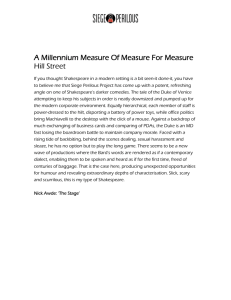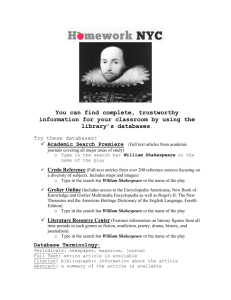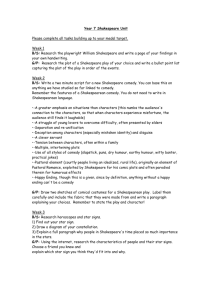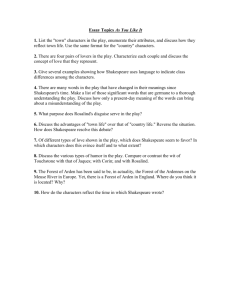COMEDY OF ERRORS (07-08) Resource Guide
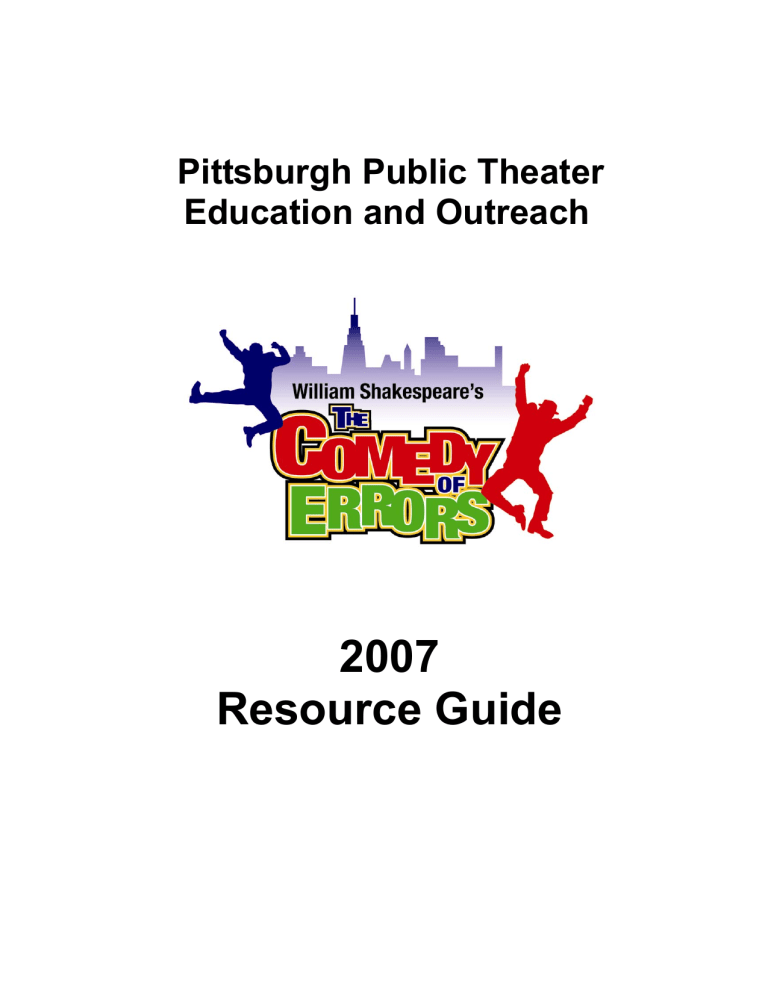
Pittsburgh Public Theater
Education and Outreach
2007
Resource Guide
About Shakespeare
By today’s standards of biography, we really know very little about William Shakespeare. By Renaissance standards, however, we know a great deal, given that he was a commoner and a theater artist. And when compared to his fellow playwrights of the period, such as
Christopher Marlowe or John Webster, the broad outlines of his life are, at least, discernible.
Shakespeare was baptized on April 26, 1564 and his date of birth is conventionally given as three days earlier, on April 23, the same day he died fifty-two years later. He grew up in Stratford-upon-Avon in a family of eight children where his father was a glover and a tradesman and held local offices in town. Though it is not known if Shakespeare attended school, due to his father’s position in the town, it is probable that he attended the King’s New School in Stratford. There he would have been taught by an Oxford graduate and would have learned Latin and Greek.
When Shakespeare was eighteen years old, in 1582, he married Anne Hathaway who was eight years his senior. Six months later Anne gave birth to a daughter,
Susanna, followed by twins, Hamnet and Judith, in 1585. Although Shakespeare went to London sometime in the late 1580s, his family remained in Stratford throughout his career.
By the 1590s Shakespeare had established himself in London as a promising young playwright. We know little about the earliest years of his career, but we do know that by 1592 the plays,
1,2,3, Henry VI, Richard III
and
Titus Andronicus
had been performed. Plague closed the London theaters from the summer of
1592 through the spring of 1594 and during this time Shakespeare wrote two narrative poems and, most likely, began composing the Sonnets.
As a member and shareholder in the acting company called The Lord Chamberlain’s Men, Shakespeare would have had many duties beyond writing plays for the company; for example, we know that he acted in two plays written by his contemporary, Ben Jonson. In 1598, the company tore down the playhouse where they performed, called The Theatre, and took the timbers to the south bank of the city where they built a new theater, the Globe.
Shakespeare was a financially successful and popular playwright in London, particularly after the theater-loving James I came to the throne in 1603 and took
The Lord Chamberlain’s Men under royal patronage (after which they were known as The King’s Men). Shakespeare used his earnings to buy the “second best house” in Stratford for his family, in addition to adjoining properties. He retired there in 1613 and died in 1616. His wife, Anne, survived him by seven years, dying in 1623, the year Shakespeare’s plays were first published in a single volume. The range of his works is truly extraordinary, comprising not only his early history plays—a genre he seems to have invented—but his comedies (
As You Like
It
and
A Midsummer Night’s Dream
) and his well-known later tragedies (
King
Lear
,
Othello
and
Macbeth
) as well. His final work of sole authorship was
The
Tempest
in 1611, after which he co-authored two plays with John Fletcher in
1613:
Henry VIII
and
The Two Noble Kinsman
.
William and Anne Shakespeare are buried side by side in the Holy Trinity church in Stratford. His gravestone reads:
Good friend, for Jesus’ sake forbear
To dig the dust enclosed here.
Blessed be the man that spares
these stones.
And cursed be he that moves my bones.
However, a more fitting epitaph is the one that was given by his friend, competitor, and fellow playwright, Ben Jonson. Jonson wrote the following tribute in the introduction to the first collection of Shakespeare’s plays:
Thou are a monument, without at tomb,
And art alive still, while thy book
doth live…
He was not of an age, but for all time.
Biography courtesy of The Royal Shakespeare Company and the University of Michigan
The Comedy of Errors
Plot Synopsis
The Story actually begins about 23 years before the play starts. While away from home, a Syracusian merchant, named Egeon, and his wife Emilia have twin boys; on the same day, in the same inn, another woman gives birth to twin boys. Since she is too poor to take care of them, Egeon takes the boys to be servants. The family sails for home but they are caught in a storm at sea. Egeon and Emilia fasten themselves and the four infants to a small mast, upon which they ride out the storm. Unfortunately, just as they come within sight of two boats and possible rescue, the mast is broken in two and the family is split apart. Egeon settles in Syracuse, where he raises one of his sons and one of the servant boys, giving them the names of their lost brothers: Antipholus and Dromio. [Years later], Antipholus and Dromio of Syracuse set out to look for their brothers. Egeon also sets out to search for his wife and other son and combs the world looking for them for five years. This is where the play begins: in the marketplace of the city of Ephesus—a city hostile to anyone from the city of Syracuse. Egeon is captured there on his way home and explains his story. Duke Solinus of Ephesus informs him that he has one day in which to pay one thousand marks or he will be put to death.
Meanwhile, Antipholus and Dromio of Syracuse have arrived in Ephesus, but they are unaware that their father is also in the city. On the advice of a friendly merchant they are pretending to be from another city to avoid trouble. Antipholus sends Dromio to take some money and wait for him at the inn where they are staying. Dromio of
Ephesus comes into the marketplace and mistakes Antipholus of Syracuse for his master, and Antipholus mistakes this Dromio for his servant. This begins a series of mistakes based on confused identities. Adriana, the wife of Antipholus of Ephesus, brings
Antipholus of Syracuse home for lunch—thinking, of course, that he is her husband— where he begins to fall in love with Luciana, her sister. When Antipholus of Ephesus is denied entrance into his own home by Dromio of Syracuse, he goes to lunch with a courtesan and other friends. The courtesan gives Antipholus of Ephesus a diamond ring in exchange for a gold chain he had ordered from a merchant. The gold merchant gives the chain to Antipholus of Syracuse instead; when the courtesan encounters this
Antipholus in the marketplace, she asks for the chain. He refuses, not knowing about the bargain she made with his brother, and she demands the ring back from him—a ring, of course, which he does not have. Finally, everyone believes that Antipholus and
Dromio of Ephesus have gone completely mad. The two men from Syracuse take refuge in a priory, while a doctor takes away Antipholus and Dromio of Ephesus to treat them for madness. They escape from the doctor, and the two sets of twins finally meet each other face to face. At the same time, they are reunited with both their father, whom the Duke pardons, and their mother, who it turns out had become Abbess of the priory in Ephesus. And then, we assume, they live happily ever after.
Plot Synopsis Courtesy of Yale Repertory Theatre
Who’s Who in The Comedy of Errors
Solinus
Duke of Ephesus
Egeon
Merchant of Syracuse; Husband of Emilia; Father of both Antipholus of Syracuse and Antipholus of Ephesus; Adopted Father of both Dromios.
Antipholus of Syracuse
One of the twin sons of Egeon and Emilia, parted in infancy from his brother. He falls in love with his sister-in-law, Luciana.
Antipholus of Ephesus
One of the twin sons of Egeon and Emilia, parted in infancy from his brother. Married to Adriana.
Dromio of Syracuse
One of the twin brothers, parted in infancy. Servant to Antipholus of Syracuse.
Dromio of Ephesus
One of the twin brothers, parted in infancy. Servant to Antipholus of Ephesus and married to Nell, a kitchen-wench.
Adriana
Wife of Antipholus of Ephesus and sister to Luciana.
Luciana
Sister to Adriana and loved by Antipholus of Syracuse.
Emilia
Wife of Egeon who is now the Abbess of the priory in Ephesus.
Balthasar
A merchant.
Angelo
A goldsmith.
Other characters:
Doctor Pinch
The Courtesan
Various Merchants
The Origins
The origins of The Comedy of Errors can be traced back much further than the Renaissance era. In fact, Shakespeare’s work is directly adapted from another famous playwright’s comedy. In 220 BC,
Roman playwright, Titus Maccius Plautus, penned a Latin language play entitled, The Menaechmi (sometimes translated as The Brothers
Menaechmus).
Plautus’ play centers on the theme of mistaken identities and follows the escapades of a set of twins known as
Menaechmus of Epidamnus and Menaechmus of Syracuse.
Shakespeare’s version did not deviate much from his predecessor’s work, aside from one major exception—he added a second set of twins! On top of having twin brothers, Antipholus of Ephesus and
Antipholus of Syracuse, the Bard introduced the identical servant characters, Dromio of Ephesus and Dromio of Syracuse. Clearly, Shakespeare realized the comedic value in his addition, as two sets of twins makes for double the confusion. The Comedy of Errors was first performed as part of Christmas celebrations at Gray’s Hall Inn in December of 1594, but the play remained relatively under-produced and obscure throughout the remainder of Shakepeare’s life.
♦
♦
FUN FACTS:
♦
At a mere 1,800 lines long, The Comedy of
Errors is the shortest of Shakespeare’s plays!
Between the years of
1589 and 1616 (the year of his death),
Shakespeare penned an average of 1.5 plays a year.
Shakespeare, one of literature’s greatest figures, did not have a university education.
The Adaptations
Although rarely performed during the playwright’s life, Shakespeare’s play gained newfound popularity in the late 1700s, and in the subsequent centuries to follow. A revised version of the comedy, entitled, See if You Like
It, or ‘Tis All a Mistake made its stage debut in London in 1734.
Around the same time, Italian playwright Carlo Goldoni wrote a Bard-influenced work called I due gemelli veneziani (“The two Venetian twins”).
Many years later in 1938, famous writers Richard Rodgers and George Abbott adapted The Comedy of Errors into a
Broadway musical titled The Boys from Syracuse. While
Shakespeare’s play was the inspiration for the musical, Rodgers and Abbott chose to use only a few lines of Shakespeare’s actual text. The Boys from Syracuse enjoyed much popularity during its Broadway run and was subsequently made into a film in 1940 and a TV movie in 1986.
Photo: Eddie Albert and Jimmy Savo – each of whom is about to encounter his long lost twin, setting off a storm of mistaken identities in The Boys from Syracuse (1938).
ABOUT THE PRODUCTION
Although Shakespeare’s language and text remains firmly intact, artistic director, Ted Pappas, has chosen to set The Public’s production of The Comedy of
Errors in a modern day metropolis. With the aid of scenic designs by James
Noone and costume designs by Martha Louise Bromelmeier, the Bard’s world comes alive in a big city setting filled with all the markings of a contemporary society. With a subway station, a coffeehouse and a delicatessen (among various other shops), the set evokes the feeling of a bustling urban business center. Additionally, Bromelmeier’s costumes lend to the cosmopolitan atmosphere by featuring a mixture of business attire, cultural clothing and casual wear.
The following are original costume sketches created by Martha
Louise Bromelmeier for The Comedy of Errors at Pittsburgh
Public Theater:
Emilia-The Abbess
Antipholus Dromio
Doctor Pinch Adriana
Comedy Creations: A Chat with Costume Designer
Martha Louise Bromelmeier
Martha Louise Bromelmeier has been designing clothing for many years. In fact, her earliest costume creations can be traced back to childhood. As a young seamstress, Martha would steal fabric from her mother’s dresser and use it to design her own clothing. Fueled by both creativity and necessity (she had difficulty finding clothes to fit her small frame!), Ms. Bromelmeier choose to pursue her design career at Ohio University where she pursued a degree in fashion. During her sophomore year, she made the switch to costume design for the theater as it better complimented her interests in history and art. After graduation from OU, Martha continued her education in Carnegie Mellon University’s MFA costume design program. Following the completion of her master’s degree, the ambitious designer moved to New York City in search of work. Since
1987, she has been successfully designing costumes for several NYC theaters such as La Mama and Primary Stages, as well as for regional theaters like Bay Street Theatre and Pittsburgh Public
Theater (where past productions include
Roleplay, Sweeney Todd,
and
The Gin Game
).
Her latest undertaking with the Public was a rather large one, as she was challenged to create costumes for a cast of 16 is this modern-day styled Shakespearean production. When asked about her inspiration for the designs, Martha pinpointed two specific influences. The first source was a picture of a storefront in Chinatown that she clipped out of the New York Times (image can be seen below). Ms. Bromelmeier stated that the colors in the image served as her main color palate for the production. She wanted to capture the bright, energetic atmosphere that is often associated with large metropolitan areas such as New York City. Additionally, she used her hometown of NYC and its residents as a major point of reference. The designer said she frequently rode her bicycle around numerous areas of Brooklyn, noting the various ethnicities and styles of clothing. Often, she would go home or to her office, and quickly sketch the interesting people that she saw.
Of course, these initial inspirations are just the seedlings of creation for the costume designer.
After the original idea emerges, the costumes must then be executed. Ms. Bromelmeier said that the time frame varies from project to project, but inevitably she will use whatever time is available to her—this could be as little as two days or as long as six months! There are always obstacles to overcome with every project, and with
The Comedy of Errors
, she was put to the task of making two sets of actors (none of whom are related) appear to be identical twins. Although it seems to be a nearly unattainable goal, it is, without a doubt, one this skillful costume designer can achieve. With her professional expertise, her creative spirit, and a needle and thread in hand,
Martha will surely continue to make designs that both inspire and entertain.
Martha’s clipping from the NY Times:
Sounding Out Shakespeare:
An Interview with Sound Designer
Zach Moore
By Alexandra Pursglove, Marketing and Promotions Intern
Photo of Zach Moore
How long have you been designing sound for The Public?
I started at The Public as the Sound Engineer when I was 18 years old. The sound engineer is in charge of the sound system and running the cues during performances.
Even though I am always the Sound Engineer, I’m sometimes hired as the Sound Designer on a show-by-show basis. You Can’t Take It With You in 2000 was my first main stage show as Sound Designer. As opposed to a sound engineer, the sound designer is in charge of deciding everything the audience hears in the show. The engineer executes that design. The Comedy of Errors will be my 40th sound design at The Public.
What made you want to be a sound designer?
Since high school, I have always done sound related work. I find sound design especially interesting because it gives you a chance to be a part of the creative team. You get to influence what is seen and heard on the stage.
What do you think is the most interesting part of your job?
I spend a lot of time at the library listening to music. I get to hear so many obscure songs while doing my research.
As a sound designer, where do you draw your inspiration from?
Every show is different for me. A comedy is looked at in a whole different aspect than other shows. Nothing is subtle in comedies, but once you figure out the music of the show, it helps to put everything else in perspective.
How long did it take you to develop the sound design for The Comedy of Errors?
We started conceptualizing about three months ago. The sound will not be completely finished until opening night. During technical rehearsals, I do a lot more hands on work, and I’m always in and out of the studio.
How do you decid e which parts of the performance should have sound and which ones should not?
Some shows, it’s obvious. For The Comedy of Errors, when there’s a slapstick fight, you know to add sound effects. For drama, you have to look for moments you want to heighten the mood or help with a transition. Sometimes silence can have more of an impact than a loud sound effect.
How much do you collaborate with the director on the sound and how much do you do all by yourself?
Sound is very collaborative. We discuss months in advance the ideas for style of music. I present the director with options and he or she gives me feedback on what fits and what doesn’t fit. They give me room to be creative, but the directors always have the final say.
Can you describe for us where you find the sounds for the show and how the sound is delivered during the performances?
Besides doing research at the library, I have an extensive sound effects library. I also create my own sound effects by personally recording them or manipulating existing sounds. We have an SFX computer playback system in which I program the sounds during technical rehearsals, so that it can all run off of a single "go" button, just like on a light board. There are specific areas where I know we’ll have cues, so I build the cues and tell the Stage Manager where they go. The Stage Manager calls them according to the action on the stage every night. Typically, every sound you hear is cued individually.
Is The Comedy of Errors more difficult than past shows you’ve done at The Public ?
Slapstick creates interesting situations. We’re still figuring out how the timing will work with the sound. There’s a lot of precise cuing in this show, so it will be tricky to get the sequences just right. I'm guessing that there will be about 100 sound cues in this show.
Do you have to be at every performance to work the sound board?
Musicals are different situations than plays—I have to be at all performances. When we do a play, I have someone working with me during tech so that they can fill in whenever I need days off. The Stage Manager calls (gives the orders for lighting cues, sound cues, etc.) everything, so I don’t have to be at every performance.
How does the sound for a comedy differ from the sound for a dramatic show or a musical? How would you compare the sound you did for The Glorious Ones with the sound for The Comedy of Errors?
Sound for a dramatic show is sometimes more realistic, or mood enhancing. In comedy, you’re always going for the laugh. The Glorious Ones was a musical, so the sound was more reinforcement than sound effects. We deal with miking the actors and musicians and the overall sound of the show for the audience. I have to make sure that everything can be heard in the theater.
Shakespeare’s Language
An understanding of the use of language can greatly enhance an audience’s enjoyment of Shakespeare’s plays. The Bard wrote in a particular style for both poetic and dramatic purposes. There are many reasons why he did this--to create a specific poetic rhythm, to emphasize a certain word, to give a character a specific speech pattern, etc. The following are brief descriptions of the main characteristics of Shakespeare’s language:
POETRY:
We speak in prose (language without metrical structure), but Shakespeare wrote in both prose and poetry. The following terms are imperative to grasping the playwright’s language:
Blank Verse : unrhymed iambic pentameter.
Iambic Pentameter: five beats of alternating unstressed and stressed syllables; ten syllables per line.
’So fair / and foul / a day / I have / not seen’
’ The course / of true / love nev /er did / run smooth’
OMISSIONS:
For the sake of his poetry, Shakespeare often left out letters, syllables and whole words. These omissions really are not that different from the way we speak today. We say:
“Been to class yet?”
“No. Heard Ulen’s given a test.”
“Wha’sup wi’that?”
We leave out words and parts of words to speed up our speech. If we were talking in complete sentences, we would say:
“Have you been to class yet?”
“No, I have not been to class. I heard that Mrs. Ulen is giving a test today.”
“What is up with that?” UNUSUAL WORDS:
Most of us run into problems when we come across old words that are no longer used in Modern English. Other times, we run across words that are still used today but have many different meanings than when Shakespeare used them. Shakespeare’s vocabulary included 30,000 words.
Today our vocabularies only run between
6,000 and 15,000 words!
To view an online glossary of Shakespearean terms, go to: http://www.shakespearehigh.com/ classroom/guide/page3.shtml
Source: Information reprinted from Shakespeare 101: A Student Guide
ACTIVITY:
Iambic Pentameter 10-line Scenes: In groups of two, have students create a short scene consisting of exactly 10 lines in which they demonstrate their knowledge of iambic pentameter. The students may choose to exclusively use
Modern English or may include Shakespearean terminology as well. After the groups have written and rehearsed their scenes, ask the students to present their work to the rest of the class.
Reflection Questions:
•
What did the students find most challenging about this exercise?
•
Did they think the forced rhythm of iambic pentameter enhanced or hindered the dialogue in the scene? Why or why not?
• How did they feel the poetic language requirements did or did not dictate character/setting choices?
THEMES TO EXPLORE
The Ties that Bind:
The Quest for Reunion in
The Comedy of Errors
A prominent feature of James Noone’s set design is a large brass compass strategically positioned on the downstage playing area. This compass is a symbol for one of
The Comedy of Errors
’ most important themes— navigating your way home. In the case of this play,
“home” does not represent a physical location alone, but also encompasses a sense of security that can only be attained by reuniting with one’s own family. In this play, a man has been separated from his wife, a mother has lost her sons, and two sets of brothers have been torn away from each other. Although nearly two decades of separation have passed, the members of this family still embark on the quest to be reconnected. The need for reunion seems especially important to the twin brothers, Antipholus of Ephesus and Antipholus of Syracuse, as they cannot fully understand themselves or feel complete until they locate their “other half.” Despite many mishaps and mistaken identities, the main characters remain steadfast in their mission to find their long lost companions. By the end of the play, all have been reunited—–husband with wife, mother with sons, and brothers with brothers. Shakespeare chooses to complete his comedy on a upbeat note with a family once torn apart by nature, now reunited by fate.
ACTIVITY:
Reunion Snapshots:
Every person will experience or has experienced a reunion of some type during their lifetime.
Whether it is reuniting with an estranged family member, reconnecting with schoolmates, or finding a lost pet, people experience a myriad of emotions when they are met with someone or something from their past. Ask your students to journal about a time when they experienced a
“reunion.” (If they haven’t experienced a reunion, ask them to write about one they may anticipate having in the future.) Encourage them to pay close attention to the emotions they felt when reuniting.
Next, in groups of 3 or 4, have the students recreate their reunion with tableau work (frozen snapshots). Each student will cast their fellow classmates as characters in their reunion story. They are to create two separate images—the moment of reuniting (a more literal interpretation) and how each person in the image
feels
during the moment (a more abstract interpretation). The groups will start out in the first snapshot (literal), then morph into the second image (abstract), and then eventually back into the original image.
While each group is posed in their snapshots, the rest of the class will be asked to comment on what they see in the images. After everyone has presented, ask the students to again journal about any revelations they might have had while sculpting images of their reunions.
Activity Extension:
After each group has presented their reunion tableaus, instruct the students to go back and create another set of images. While keeping the “reunion” image the same, have the students create a
“moment before” (what happened directly before the reunion) snapshot, and then create “a moment after” image (this could be immediately after the reunion or a year from that moment). Present.
THEMES TO EXPLORE:
Slapstick Comedy and the Tradition of
Commedia dell’arte
Commedia dell’arte is a popular form of improvisational theater that originated in Italy in the 15th century. Commedia troupes consisted of 10 people: 7 men and 3 women. Each actor specialized in a particular type of character that appeared over and over again in different situations. Some of the most famous stock characters included the Harlequin (the tricky servant), Pantalone (the old miser), and Pulcinella
(the cruel, hump-backed old man). The group’s performances were improvised around a repertory of conventional situations such as old age, jealousy, and love. The actors would insert rehearsed gags and pratfalls called lazzi into the scenarios . During the lazzi, the actors would frequently use a prop known as the slapstick. The prop was made from two flat sticks that were attached at the base, and when it was used on someone it would make a loud smacking noise. Although it sounded painful to the audience, the actor was not actually hurt by the slapstick.
The prop did eventually disappear from theater stages, but its name—slapstick—came to be known as a particular style of comedy. “Slapstick” is often associated with an over-the-top brand of physical humor that features unrealistic violent bits. Modern-day examples of slapstick comedy can be seen in performances by the Marx Brothers and The Three Stooges.
The Public’s production of The Comedy of Errors features many moments of farcical humor. Director
Ted Pappas certainly pays homage to these comedic predecessors by including the traditions of both commedia dell’arte and the “slapstick” comedians of the
20th century.
Polichinelle (Pulcinella), c. 27 x 19 cm. Chez N.
Bonnart, c. 1650
ACTIVITY:
Contemporizing Commedia:
Reference: www.commedia-dell-arte.com
The website above provides detailed descriptions of all the stock characters in commedia dell’arte. After researching the characters with your students, conduct the following activity:
Break your students into groups of 5 and give them large pieces of paper to write on. Instruct them to choose 5 commedia characters and write the names at the top of paper. Underneath each name, the students will then brainstorm similar stock characters who would be relevant in modern-day society. After they have selected a contemporary equivalent for the tradition commedia characters, they are to create a short scene using one of the following stock scenarios :
• Jealousy
• Falling in Love
• Betrayal
• Mistaken Identity
The scenes should be a maximum of 5 minutes in length, should incorporate all 5 characters, and needs to have a clear beginning, middle, and end. Each group will present their scene to the class.
————————————————————————————-
DID YOU KNOW???
Last season, Pittsburgh Public Theater produced a brand new musical by the writing team of Lynn Ahrens and Stephen Flaherty called,
The Glorious Ones
, which is entirely based on the tradition of commedia dell’arte
.
The show is now currently going in to production at Lincoln Center Theater in New York
City, and will open in late October, 2008!
AFTER THE SHOW QUESTIONS:
•
•
•
•
• What surprises did you encounter in the scenic design? How did these elements contribute to the action or the thematic emphasis of the production of Comedy ?
The production contains many elements of slapstick and farcical humor. Can you point out any specific moments in the play where you saw these types of comedy being used?
Which character did you identify with the most and why?
How did the Antipholus brothers differ from one another in personality? How were they similar?
How did Shakespeare give the play a satisfying ending? Was this ending effectively realized in the
Public’s production?
WANT TO LEARN MORE?
Shakespeare Resources:
Renascence Editions: An Online Repository of Works Printed in English Between the Years
1477 and 1799.” Richard Bear, University of Oregon.
<http://www.shu.ac.uk/emls/iemls/resour/mirrors/rbear/ren.htm>
* Read all of Shakespeare’s works as well as those of his
contemporaries. Works are divided by author.
“Shakespeare in Quarto.” British Library.
<http://www.bl.uk/treasures/shakespeare/homepage.html>
* This site provides access to 93 copies of 21 Shakespeare plays.
Viewing juxtaposed texts, comparisons between versions can be
made. Background information and critical options are also provided.
“Shakespeare’s Life and Times Home Page.”
<http://ise.uvic.ca/Library/SLT>
• This link provides the option between a full and simple version of the “Life and Times”
page. The site is divided into seven “Books” related to
Shakespeare and his plays: Shakespeare’s life, the stage, society,
history and politics, the background of ideas, the drama, literature/
art/music, some plays explored and references and indexes.
* For a guide to Elizabethan language follow the literature/art/music link,
and click on the “Elizabethan English” chapter .
“Shakespeare Resource Center.”
<http://www.bardweb.net>
* This site has information on Shakespeare’s life, literary works, his
theaters, his critics, his language and his world. The information
provided is concise and easy to understand.
* Each section has a list of links for additional resources on the
internet. Extremely thorough, highly recommended!
**
For a list of PA Academic Standards related to this and other upcoming productions, visit our website at http://www.ppt.org/content/theaterlinksresources.cfm
**
14th Annual Shakespeare Monologue & Scene Contest
Don’t miss out! Go to www.ppt.org to learn more.
November 1, 2007-January 25th, 2008– Online Registration
January 11– February 8, 2008– Coaching Sessions
February 11-15, 2008– Preliminary Round
February 18, 2008– Showcase of Finalists
Suggested Classroom Monologues and Scenes from
The Comedy of Errors:
Scenes:
Abbess and Adriana, Act V, Sc.1- “
Be quiet, people; wherefore throng you hither?”
Adriana and Luciana, Act II, Sc.1- “
Neither my husband nor my slave return’d”
Dromio of Syracuse and Antipholus of Syracuse, Act. III, Sc. 2- “
Why, how now Dromio, where run’st thou so fast?”
Monologues:
Adriana, Act. II, Sc. 2-
“Ay, ay, Antipholus, look strange and frown…”
Antipholus of Syracuse, Act. III, Sc. 2-
“Sweet mistress, what your name is else I know not.”
TELL US WHAT YOU THINK:
Pittsburgh Public Theater looks forward to receiving teacher and student feedback. Please share your thoughts about the play, the Resource Guide, and your experience at Pittsburgh Public
Theater. Feedback may be sent to:
Pittsburgh Public Theater
Attn: Education Dept.
621 Penn Ave.
Pittsburgh, PA 15222
Or email us at klink@ppt.org
This Resource Guide was created by: Kristen Link, Education & Outreach Coordinator. The Education & Outreach Department would like to thank Martha Louise Bromelmeier, Zach Moore, Alexandra Pursglove, The Royal Shakespeare Company, The University of Michigan and Yale Repertory
Theatre for their contributions to this guide.

